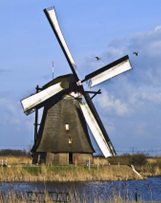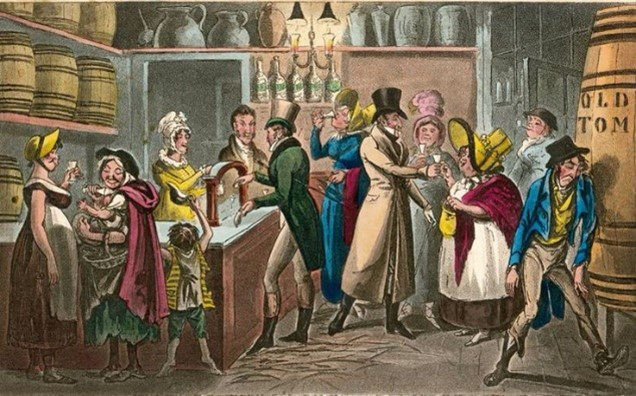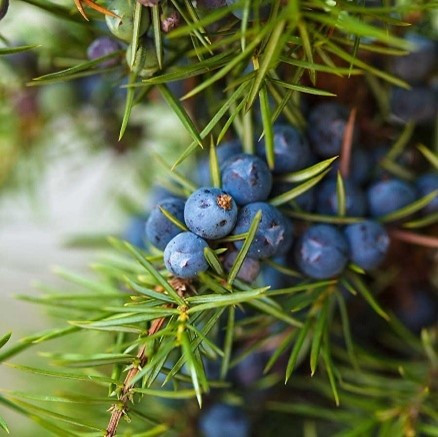



The Story of Gin
Let’s look at gin. The spirit’s name comes from the French word for the juniper berry, genièvre. The Dutch changed it to genever. Eventually, the English shortened it to “gin”.
Women in the Netherlands made a clear distilled spirit in their kitchens. It was flavored with botanicals, especially juniper. The juniper was added to mask the harshness of the beverage. This cottage industry generated money that the women distillers could call their own. They made a mash from barley malt which was fermented, like beer, and then distilled. This “malt wine” was 50-55% alcohol by volume (ABV) or 100-110 proof.
As the spirit grew in popularity, men noticed and took over the industry. Franciscus Sylvius, a 17th-century university professor of medicine is credited with developing gin. His goal was to create cheap medicine. Did he really invent something women had been making at home for years?
Queen Elizabeth I sent troops to help Dutch Protestants in their revolt against Catholic Spain. When the troops returned home, they had acquired a taste for a new drink, genever. English women used surplus grain and began making, selling, and enjoying “gin”. Woman-run gin shops, Strong Water Houses, sprang up all around London. These female-centered businesses were the only place where women could drink in public without harming their reputation. Because of the women distillers and with so many women enjoying gin, it became known as “Mother Gin”, “The Lady’s Delight” or “Madam Geneva”.
This early English gin wasn’t made with juniper. It was often mixed with turpentine, salt, pepper, ginger or almond oil making it a very harsh beverage. The process used by English distillers wasn’t refined until the mid-1700s. Early gin was 57% ABV. Everclear, aka white lightning, is 60% ABV.
The English were accustomed to low alcohol ales. When gin arrived, pubs served it in equal amounts as ale – if it’s a pint of ale, why not a pint of gin? It hit a peak during the London Gin Craze of 1720-1751. The city was flooded with cheap gin resulting in mass drunkenness, alcohol poisoning, and deaths. This also became the spark for the Temperance movement.
Parliament tried to control gin consumption with a Gin Act passed in 1736. It targeted the women-run gin houses and imposed a retail tax. This had little impact. Parliament went on to pass seven more Gin Acts until a final effort in 1758. All attempts failed.
Gin’s popularity soared in America during Prohibition (1920-1933). Gin didn’t need to be aged in barrels like whiskey or bourbon, so it was ready to drink quickly. “Bathtub Gin” wasn’t really made in bathtubs. The idea comes from bootleggers filling large jars with gin and steeping it with juniper berries. They also added water to dilute the concoction. The large jars were too big for the kitchen sink, so the bathtub was used.
Modern gin starts with malted barley, fermented and distilled and purified to create a flavorless, and almost neutral spirit, think vodka. It’s high in alcohol, 90%-94% ABV. To transform it into gin distilled water is added, and the mixture is distilled again but this time with botanicals, often juniper berries. Some distillers use other botanicals including licorice root, citrus peels, caraway, coriander, anise, and fennel. The final product usually is 40-47 ABV (80-94 proof).
Types of Gin
Genever – the Original
Genever or Jenever in Dutch started back in the 16th century when women in the Netherlands and Belgium began distilling spirits at home for sale. Sometimes referred to as “malt wine” since, like whiskey, it starts with fermented malted grains. The flavor is not dominated by juniper. Today it is usually
aged for 1-3 years. Depending upon its age, it can be classified as Oude (old) or Jonge (young).
Plymouth Gin
It was first created in 1793 at a distillery owned and operated by monks in Plymouth, England. It is made with juniper, citrus and a blend of seven botanicals. This blend gives it earthy and tart notes and a full body. It’s smoother than London dry gin. Plymouth gin was the most popular style of gin in the early 1900s. Today it is produced at only at the original distillery.
Old Tom Gin
Many consider Old Tom to be a missing link between Genever and London dry gin. It is sweeter than other gin styles. Developed in England during the 1700s, it was the main style until London dry gin came along. It’s usually light on botanicals but licorice root is often added. It can be barrel aged or not, depending on the distiller. It was the gin used in the original Martini.
London Dry Gin
This is what most people think about when you say gin. It’s the iconic and most popular style today. In the early 1800s, London was flooded with bad gin. Deaths from alcohol poisoning were mounting and gin was getting a bad reputation. A group of London distillers decided to create a less lethal and higher quality product. They wanted London dry to become a “brand name” that denoted high standards and easy drinking. Small amounts of sweeteners are added to dry gin. No coloring or flavoring is added so the gin is clean and crisp with a strong juniper flavor. It doesn’t have to be made in London.
New Western Dry Gin/American Dry Gin
This style’s roots go back to Prohibition (1920-1933). Bootleggers and speakeasy owners were making “bathtub” gin by adding juniper oil, tree resin or other flavors to a neutral grain spirit (vodka). These additions were often not completely filtered out so the gin could change flavor and color over time. It was widely known to be of questionable quality. This gin style returned as a much-improved unique style in the early 2000s. Craft distillers used regionally available botanicals including seaweed, lemon grass, or even olives. It has a mild juniper flavor. This gin incorporates a wide range tastes and flavors since it has no legal definition.
Navy Strength Gin
This is a higher alcohol, overproof spirit that must be at least 57% ABV (114 proof). Officers in the British Royal Navy received a daily gin ration of one pint per day. The gin had to be high enough in alcohol so “If the gin were to spill on gunpowder, the powder would still light.” This is a fiery or spicy tasting gin.
Aged Gin/Reserve Gin
This gin is aged in wooden barrels. The spirit picks up new flavors and some color from the barrels. The final product has a mellow flavor and soft bite.
Sloe Gin
This college student’s nightmare is technically not gin. It’s a distilled spirit sweetened with sugar. To give it the characteristic color, blackthorn berries are added to the spirit before letting it sit for three months. It is often sold as a liqueur. It must be at least 25% ABV. “Sloe” is another name for the blackthorn berry.